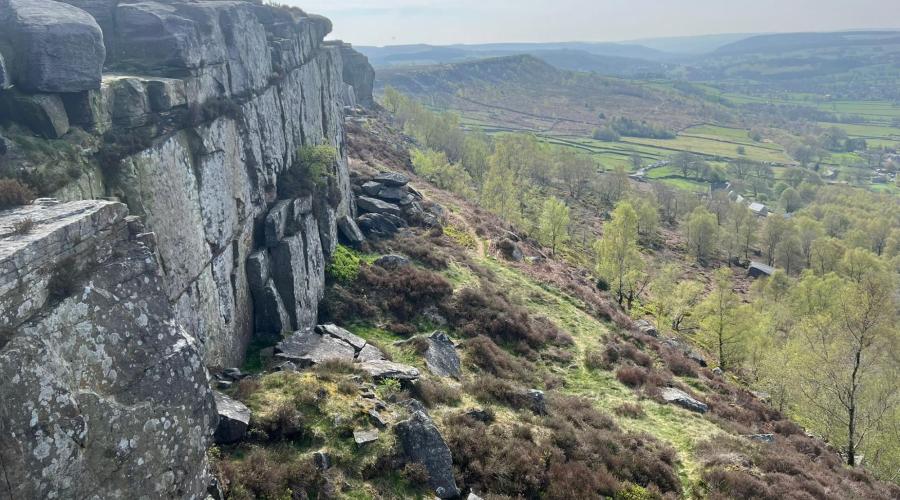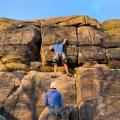Outdoor Climbing - Froggatt - (Beginners & Intermediate)
8 people attending
2 places left
Never climbed outdoors before or need a refresher? You're in the right place, our leaders will show you the ropes and you'll be climbing the crags in no time.
Climbing is a total body workout. It is not just about strength, but requires balance, problem solving and planning. Outdoor climbing is a fun way to stay fit, make new friends and get out in the fresh air. This event will allow you to develop your climbing skills in the beauty of one of the renowned gritstone crags of the Peak District, which is our oldest National Park.
We will be setting up some top ropes with bottom belay positions at the crag for you all to use over the course of the evening, similar to what you would find at an indoor climbing wall.
Froggatt offers a variety of climbs, and the team will ensure that you both enjoy your Trad Climbing experience but are also challenged. There may also be the opportunity to abseil/rappel down a selected route where a dedicated Group Abseil point will be established.
For those intermediate climbers attending, routes will be established with leader placed gear, these routes will be led by experienced ODL Trad climbers, this will allow your development through seconding a route and clearing the gear.
What is Seconding?
If you're seconding a route, you'll follow the climber who led the route up (see below for explanation on leading), placed gear (nuts, cams, quickdraws, etc.) and attached the rope to the gear they placed. In a group of three:
- The first second climbs the route with the rope already in place, primarily focusing on movement and getting used to the rock. This climber does not remove any gear, but will need to unclip the rope and re-clip as they pass any protection.
- The second second follows after and removes the gear (nuts, cams, quickdraws, etc.) that was placed by the leader. This is a vital role and a great way to build an understanding of traditional protection placements.
Seconding allows you to experience outdoor climbing with less pressure than leading while still engaging with gear and rope systems. It’s an ideal way to build outdoor climbing experience before leading your own routes.
What is Leading?
This person goes up the route first, placing protection or gear (nuts, cams, quickdraws, etc.) to protect themselves as they ascend.
Once they reach the top of the route, the lead climber's job is to:
- Build a secure anchor using fixed gear (like bolts) or traditional protection (nuts, cams, etc.)
- Set up the system so others can safely climb the route on top rope (Not to be confused with top roping indoors)
After the anchor has been built, the role of belaying switches from the person on the ground, to the person who lead the route from the anchor they have built at the top of the climb.
When second climbers ascend the route on top rope:
- They are protected from above by the rope, so any fall is very short.
- They climb to the top, and top out rather than being lowered back to the ground.
IMPORTANT! - Participation Statement
You MUST complete a Participation Statement, in addition to booking your event space before attending an OutdoorLads event. You only need to complete this Participation Statement once, not for each event you attend.
Please note that every person participating should be aware of (and accept) that those members perceived as ‘in charge’ or leading the event are not experts, do not need to be experts, and are not regarded by OutdoorLads, or themselves as experts, but are amateurs with some experience in the event type and who are happy to impart their knowledge. Any advice given should be considered with this in mind by the recipient.
By signing up to and attending an OutdoorLads event, you are confirming that you have read, understood and accept the content of this statement.
Please see our website for more information including an FAQ about our events.
Image credits - all images provided by OutdoorLads members. OutdoorLads has permission to use them.
















What to bring
Climbing Equipment: If you have your own climbing harness, shoes, chalk, belay device, helmet or screw-gate karabiner please bring these along, making sure they are in good condition before you do so. Equipment will be available to borrow for those who don't have their own.
What to Wear: It is best to wear combats, tracksuit bottoms or walking trousers. No jeans or any form of trouser which hampers movement. A t-shirt or vest is also suitable and please bring warm layers, a warm hat and a windproof or (ideally) a waterproof to wear as Stanage Edge is notoriously breezy even in good weather - and the weather may end up being changeable. Sunglasses and sun cream too if the forecast looks sunny. If you have any OutdoorLads branded clothing then please try and wear this as it will give the group a good level of visibility. Any jewellery such as rings, watches, chains or bangles should be removed before beginning the session to prevent injury. Please wear sturdy trainers as there will be a short walk across uneven moorland to the crag. These are also useful to wear when belaying a climber and for climbing too for those who do not have climbing shoes. It's also worth wearing or bringing a pair of thin liner or sports socks because if you wear climbing shoes your feet can sometimes get quite cold when climbing outdoors.
Food & drink
Please bring snacks, water and any hot drinks you'd like with you as there is nowhere on-site to get food and drink and if you vacate your parking spot during the day to go and get food it'll probably be taken by the time you get back!